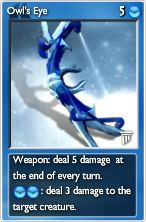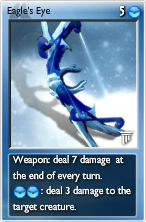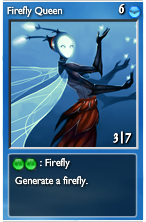


I've always considered Wings to be one of the most interesting Air cards. Against some decks, it is powerful enough to win you the game all by itself. Against others, it is entirely useless. Any deck that wants to slow down the opponent can benefit from the addition of Wings, whether they aim to win by deck out or by damage. Simply play it once your opponent has developed two or three creatures onto the board.
To better understand what it is capable of, and to have a better idea of its limitations, in the spoilers below are the creatures that can hit past Wings and the creatures that cannot.
When you look at the list of creatures blocked by Wings, you'll notice that it blocks many of the most efficient damage-to-cost ratio creatures in the game. Lycanthrope, Mummy, Graboid, Shrieker, Lava Golem, Nymph Queens and Ghost of the Past in particular are all staple cards in some of the fastest decks in the game, both in their upgraded and unupgraded forms. If you want to run a deck with less efficient, slower creatures you need some way to catch up with these faster creatures. Wings gives you 5 turns to do so, which is normally more than enough.
The drawback, of course, is flying creatures. If you're relying on Wings to buy you those extra turns you need to win against a faster deck, and the faster deck is running flying creatures, then it will be a short, painful game for you. Phoenix, Gargoyle, Psions, Sapphire Chargers, many of the Dragons, and in an upgraded format Wyrms and Guardian Angels are all cost efficient creatures that are not blocked by Wings. So how can you mitigate this weakness?
Flesh Spider/Phase SpiderTwo powerful cards to use in combination with Wings are the Spiders. Their ability, Web, removes Airborne from the target creature. With a couple of these around even a whole deck of Airborne creatures will have a hard time dealing damage past your Wings. As a bonus, when upgraded both cards are extremely efficient damage dealers.
Owl's EyeAlthough less obvious than the Spiders, Owl's Eye is another great addition to a deck with Wings. The ability, Snipe, can kill many dangerous flyers with only one use, such as Seraph, Crimson Dragon, Gargoyle, and Forest Spirit. After 2 uses only 5 Airborne creatures survive, and none of them are very efficient damage dealers. This means that it is very difficult to quickly deal damage past Owl's Eye and Wings when used in combination.
Reverse TimeMany of the cards that can hit through Wings either deal very little damage, or cost an awful lot of quanta to play. Reverse Time loves targeting expensive creatures - forcing your opponent to use their quanta to play one creature over and over and at the same time denying their card draw is very powerful. And if your opponent is using creatures that deal very little damage, well... What are you worried about?



Owl's Eye is, perhaps, my favourite card in the game. It has a good damage-to-cost ratio, both upgraded and unupgraded, which makes it a good choice in aggressive decks. However, the incredible and unique ability is what makes this card so powerful, and a staple in any Air deck that aims to control the opponents creatures. Few cards can generate as much card advantage as this one can.
It is a card that is best used as soon as you draw it, as the ability is limited to one use per turn. The more turns Owl's Eye is on the field, the more creatures you can kill with it. Sniping a high value creature like Crimson Dragon or Arctic Squid can often turn the tide of a game. There are many cards that have great synergy with Owl's Eye. A few of my favourites are listed below.
Flying WeaponWhat's better than one Owl's Eye? Two Owl's Eye! With two, three, or even more of these on the field it becomes extremely difficult for your opponent to play creatures that will survive the turn.
SanctuaryAs Owl's Eye is a card that can generate enormous card advantage if given enough time, it makes a lot of sense to play it with cards that will give it that time. Sanctuary performs this task perfectly. Whilst Owl's Eye is in the process of killing any creature your opponent plays, Sanctuary heals off any damage those creatures have dealt to you. This combination can be extremely difficult to play against, and is the base for one of the most powerful deck out decks in the game - the Air/Light stall.
BonewallOwl's Eye is a card that can kill a lot of creatures over the course of a game. Bonewall not only gives Owl's Eye the time to kill your opponents creatures, but it also gains layers for each creature that dies. Once a Bonewall is played with an Owl's Eye on the field, there's a good chance that the Bonewall will last until the end of the game.



Although one of the Air cards that sees the least play, Firefly Queen fills an interesting niche. After using her ability three or four times, the damage output from Firefly Queen is enormous. This, plus her high starting health, make her an extremely effective card for any Air/Life or Rainbow deck that need either a high damage output from few card slots or a better ability to stall break. Notable examples of these kinds of decks are Adrenastaves (Adrenaline, Druidic Staff, and Flying Weapon) and various Rainbow stall decks. When you play a Firefly Queen, you should aim to use her ability every time you have the opportunity to do so.
In fact, Firefly Queen has such a powerful ability that it's not unusual to see entire decks built around her. As Firefly Queen is a card that starts slowly, many of the cards in these decks are there to help you survive the weak early game phase. These can be cards such as Wings and Owl's Eye, both mentioned above, Shockwave, Thunderstorm, and many others. Some of the most interesting cards are mentioned below.
HopeThis shield is a key card in any Firefly Queen deck. Each time her ability is used, a Firefly with Bioluminescence is created. For each Firefly, Hope will block 1 damage from each enemy creature. This combination can grow out of control very rapidly, and will often be enough to lock decks out of dealing any damage at all for the rest of the game.
Empathic BondFirefly Queen is a card that will produce many creatures over the course of a game. Empathic Bond uses these creatures to help Firefly Queen decks survive the mid-game, and it single handedly allows allows them to beat Poison decks. However, although powerful they are quite expensive cards. I would recommend only using two or three in one deck.
Shard of FreedomFirefly Queens are quite vulnerable to Creature Control cards like Basilisk Blood, Gravity Pull, and Reverse Time. Shard of Freedom offers some protection against those cards, and provides a great damage boost and very valuable shield bypass. As Firefly Queen produces so many creatures each Shard can have a big impact.

